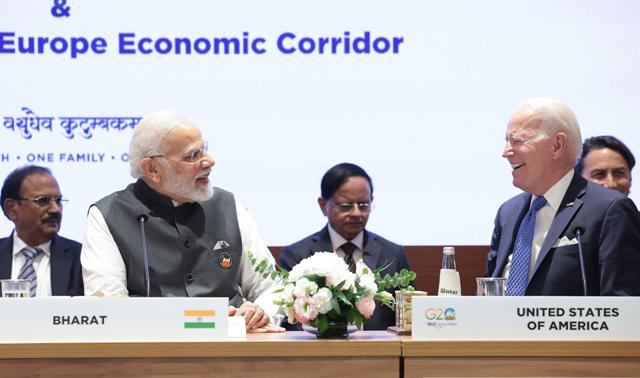 New Delhi, 9th September, 2023: Prime Minister Narendra and President Joe Biden at the Partnership for Global Infrastructure and Investment & India-Middle East-Europe Economics Corridor event during the G20 Summit. [photo: PIB/Press Information Bureau/ Alamy]
New Delhi, 9th September, 2023: Prime Minister Narendra and President Joe Biden at the Partnership for Global Infrastructure and Investment & India-Middle East-Europe Economics Corridor event during the G20 Summit. [photo: PIB/Press Information Bureau/ Alamy]
[This article is an excerpt from an article in The Round Table: The Commonwealth Journal of International Affairs.]
Incongruities and misgivings
Essentially, New Delhi wants a ‘strategic space’ that is free from any foreign diktats and one that has enough room for manoeuvrability of policies (Sridharan, Citation2017). Washington has now come to acknowledge this longstanding posture. The agreements that the US and India have signed so far show that New Delhi has been treated as a ‘global strategic partner’ (Business Standard, Citation2023b). Eventually some Senator in the US will ask the uncomfortable question, ‘What is the US getting in return, besides India’s sizeable market?’ Tellis argues that Washington’s ‘big bet’ on India is ‘bad’ as it is unlikely to bring about a fundamental change in its ‘go it alone’ policy and that Washington should come out of the ‘delusion’ that New Delhi will become a ‘comrade-in-arms during some crisis with Beijing’ (The Hindu, Citation2022; Tellis, Citation2023). As of today, given India’s priorities, it is quite likely that the United States will not obtain any assurances or commitments from New Delhi in armed conflict circumstances in which India is not a participant.
India’s exercise of strategic autonomy has meant that it has taken decisions according to the exigencies of the situation. In recent times, India has not only ramped up the purchase of discounted oil from Russia but it has deepened its engagement with non-western multilateral frameworks. Furthermore, India’s ‘floating’ status in the Quad has caused some unease with the US (Zeeshan, Citation2022). India’s unspoken but aspirational voice to lead the Global South serves as a warning to the US-led West that it is somewhat dissatisfied with the current global order. Washington has chosen to overlook such anomalies due to the complexity of the situation and its future relations with India. But it does point towards certain fundamental contradictions between the US and India. Until recently, New Delhi’s relative power imbalance with Beijing has meant that the former had to look towards Russia to act as an ‘external balancer’ (ANI, Citation2022). Presently, given the growing dependence of Russia on China rather than the other way around, it does have major implications for India. Therefore, India has sought to diversify its defence purchases as well as strengthen its relations with the US. For the time being, India’s ‘ultra-realist foreign policy approach’ has helped it replenish its coffers, but has it has unnerved the West (Grossman, Citation2023).
India at 75 – India’s foreign policy: shift, adjustment and continuity
India’s place in America’s world under the Biden presidency: decoding the China factor
Both Washington and New Delhi are apprehensive about how each would address the threats emanating from Beijing. Washington is concerned about India’s nuanced posture on its security interests in the Indo-Pacific; New Delhi is wary of Washington’s support in the event of a future border clash with China along the LAC. Essentially, India too is cautious about placing a ‘bet’ on the US at the moment. Again, while the wedge between Washington and Moscow seems to have become a permanent one, the same cannot be said with the former’s relations with Beijing. Despite tensions between the two countries, China remains the United States’ third-biggest trading partner (Census Bureau, Citation2023). Given the high volume of bilateral trade, for the US administration China is a ‘peer’ (Dobbins et al., Citation2019). As Beijing remains a ‘strategic competitor and not an enemy’ for the US, the two countries have little option but to keep their diplomatic lines open (Bader, Citation2020; Wintour, Citation2023). Likewise, despite the tensions along the LAC, the irony is that China too is India’s second largest trading partner. New Delhi is well aware that stable ties between China and the US are necessary for global economic growth, and there is a nagging concern that Beijing and Washington may each carve out their own zone of influence, leaving the nations of the Global South in the lurch. Therefore, India’s strategy to remain multi-aligned without any commitment to any party is here to stay, unless Moscow changes its stance on India’s core interests and toes Beijing’s line of questioning the territorial integrity of the country.
Though the foundation of US-India relations is fairly strong given that it rests on strong diaspora ties, economic linkages and ‘democratic values’, it does have its weaknesses (U.S. Department of State, Citation2022). The present political regime in India has made it clear that it would not allow questioning of its institutions or policies from the Western press or diplomats. With the Modi government perennially in an election mode, issues of foreign policy have now been included in its political gambit. While Pakistan and China continue to be the target of the BJP in election rallies, the West has not been spared. PM Modi has often urged the people to abandon their ‘colonial mindset’ (Business Standard, Citation2022). The Modi government has criticised global indexes and the involvement of Western media for harming India’s image.
Shubhrajeet Konwer is Associate Professor, Department of Political Science, Gauhati University, Guwahati, Assam, India.



